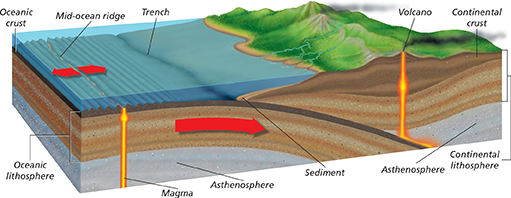Sea-floor Spreading
Several decades after Wegener proposed his hypothesis, new evidence led geologists to reconsider his ideas. Some of this evidence came from mapping the sea floor and studying the characteristics of oceanic crust. This evidence helped scientists propose the theory of plate tectonics.
Figure 25 This false-color satellite image shows a segment of the mid-ocean ridge found in the Atlantic Ocean. Known as the Mid-Atlantic Ridge, it is part of a larger ridge system that winds through all of Earth's oceans.

The Mid-Ocean Ridge
If you go swimming in a lake, you expect the water in the middle to be deeper than near the shore. Surprisingly, this is often not the case in oceans. When scientists mapped the ocean floor during the mid-1900s, they found a chain of underwater mountains which they called the mid-ocean ridge. Like the seams on a baseball, the mid-ocean ridge extends into all of Earth's oceans. It forms the world's longest mountain chain. A segment is shown in Figure 25.
As scientists mapped the Atlantic mid-ocean ridge, they found that it had a remarkable feature: a deep valley running the length of its crest. Scientists also discovered that the rocks of the ocean floor were youngest near the mid-ocean ridge. At first, scientists were puzzled by this new information.
Formation of Oceanic Crust
In 1960, geologist Harry Hess proposed the theory of sea-floor spreading to explain these discoveries about the ocean floor. Sea-floor spreading is the process by which new oceanic crust is created at mid-ocean ridges as older crust moves away. The mid-ocean ridge is a huge crack in the crust where magma is pulled upward. As shown in Figure 26, the pieces of ocean floor on each side of the central valley are slowly moving apart. As they move, magma from the mantle wells up and solidifies to form new oceanic crust.

What is sea-floor spreading?
Figure 26 During sea-floor spreading, oceanic crust forms at the mid-ocean ridge. This crust gradually moves toward a subduction zone, where old crust sinks beneath a trench.
Inferring Where is the oldest oceanic crust found?
 d
d



